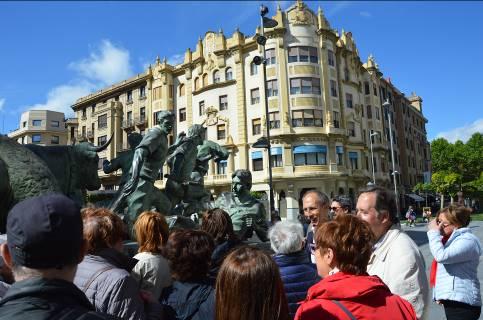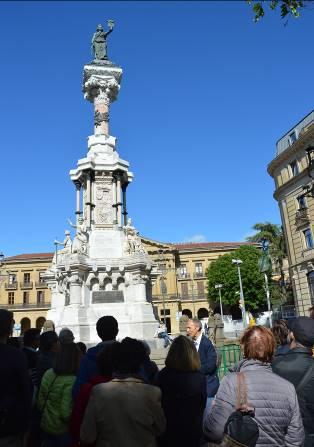29 May
lecture series
THE WORK IN ITS CONTEXT
Discovering Pamplona's urban heritage: commemorative monuments (I)
José Javier Azanza López
Chair de Patrimonio y Arte Navarro
The commemorative monument is one of the main artistic manifestations in Navarre during the 20th and 21st centuries. In addition to its aesthetic and formal value, it has an ideological component, which makes it a talking element that carries within itself the political, social or cultural load of the moment in which it was erected, in such a way as to capture in stone, marble or bronze a way of being or thinking, a conduct to be followed or imitated, the idiosyncrasy on many occasions of a locality or of an entire community. Understood as a sign of identity, the commemorative monument bears some parallels with 19th-century history painting: technical and formal differences aside, one is to sculpture what the other is to painting.
In this activity we propose a tour of a group of commemorative monuments in Pamplona, through which we will examine the characteristic features of this type of monument: promoters, materials, formal layout, themes and iconography. Focusing on one sector of the city, we will leave for later sessions other itineraries that will complete our approach to Pamplona's urban heritage.
We begin our visit to visit at the Monument to the Running of the Bulls ( 2007), at the crossroads between the avenues of Roncesvalles and Carlos III, the work of the Biscayan sculptor Rafael Huerta Celaya (Bilbao, 1929), son of the sculptor Moisés de Huerta, an artist trained at the technical school de Bellas Artes in Madrid and a teacher at the Schools of Arts and Crafts in Corella and Pamplona. While at director in the latter, in 1991 he was commissioned by Pamplona City Council to create a monument to the Running of the Bulls, thus beginning a long process that would reach its midpoint in 1994 with the inauguration of a first sculptural group in an abridged version of the original project , and which would culminate in 2007 with the inauguration of the definitive set at framework in the process of pedestrianisation and embellishment of the Avenida de Carlos III.

The artist, who conceived the monument as a tribute to his adopted Navarrese homeland, created a sculptural group of nineteen figures (six bulls from the Victorino Martín bull-ranch, three bell-oxen and ten runners) which immortalise in patinated bronze a picture of the fast degree program run along the Estafeta stretch, whose slightly sloping cobbled ground simulates the surface of the monument. The group shows the different lances that take place during the encierro, from the runners who open the degree program and pull the pack, to those who have already been overtaken by the bulls, without forgetting the runners who fall to the ground (one of them is a self-portrait of the artist) and those who have been overtaken by the bulls.
Rafael Huerta demonstrates his technical ability in the balance of volumes and masses to achieve an ensemble characterised by its plastic lightness, expressiveness and tension, all within a figurative language that defines his sculptural production, as he shows in other monuments in Pamplona dedicated to Nicasio Landa and José Joaquín Arazuri, or in sculptures such as El Sueño (The Dream) or Reboteando de revés (Rebounding backwards).
A short distance from the previous one, at the junction of Avenida de Carlos III and place del Castillo, is the Monument to Carlos III the Noble (2004), by the sculptor Francisco López Hernández (Madrid, 1932-2017), of training academics in Madrid and Rome and a member of the so-called "Madrid Realist School". Although the Scientific, Artistic and Literary competition organised by Pamplona City Council during the San Fermín festivities in 1907 included the creation of a project monument to the report of the Noble King, almost a century would have to pass before it became a reality. Inaugurated on 8 September 2004, it pays homage to the monarch who on the same date in 1423 put an end to the confrontations between the three boroughs of Pamplona (Navarrería, San Cernin and San Nicolás) with the promulgation of the Privilege of the Union, by which they were united into a single town council.
The sculpture, cast in lost-wax bronze, depicts the monarch standing, in the attitude of submit the Privilege of the Union which he holds in his right hand, while he bends his left hand towards his chest with a solemn gesture. Francisco López, one of the most genuine representatives of contemporary Spanish sculptural realism, created a figurative work inspired by the Gothic tomb of Charles III in Pamplona Cathedral, from which he took specific details such as the features of the face or the fleurs-de-lis adorning his clothing and crown, with the aim of making him more identifiable and recognisable. purpose .
Moving on in our tour we reach the Monument to the Fueros ( 1903), erected at one end of the Paseo de Sarasate, in whose construction the architect Manuel Martínez de Ubago (Pamplona, 1869-Zaragoza, 1928) took part as the author of the project, and the marble worker Ramón Carmona (Pamplona, 1871-1929) as the creator of the sculptures of the first body. The monument to the Fueros was a milestone in the complex configuration of Navarre's contemporary identity - it was even defined as "the symbol of our liberties" or "the petrification of Navarre's enthusiasm" - as it symbolised the reaction in defence of its rights against the anti-foral project presented in 1893 by the Minister of Finance Germán Gamazo, who considered that it undermined the fiscal autonomy recognised in the Ley Paccionada of 1841. The idea of incarnating the Fueros in a monument came from the comedian Fiacro Iraizoz, immediately promoting an executive commission that determined its execution by means of popular subscription, for which a minimum fee of 25 cents and a maximum of 25 pesetas was set. Although at first it was thought that it would be placed at place de la Constitución -currently the Castle-, it was finally decided to erect it at the eastern end of the then Paseo de Valencia, opposite the Palacio de la Diputación.
The foundation work was completed in December 1895, at which point construction work on the monument progressed very slowly due to economic difficulties. This is the main reason why in 1895 the Pamplona architect was forced to modify the original project , especially at the top, where the sculptural group of two warriors - an old man protected by a young man - initially shown was replaced by the final female figure. A sketch by Manuel Martínez de Ubago also survives, in which a large cup or vase with floral motifs crowns the whole; if the latter had been carried out, it would have completely distorted the allegory of the vindication of the foral right.

Once the architectural part had been laid out, the execution of the allegorical images for the first body was entrusted by the Bilbao contractor Eugenio Arrese to the Pamplona marble worker Ramón Carmona; carved in Angoulême stone, they were placed between February and June 1903. Around the same time, the bronze statue of the coronation arrived in Pamplona by train, commissioned from the Fundición Artística Masriera Campins of Barcelona, signature , which supplied most of the Spanish public statuary of the late 19th and early 20th centuries. At 4.30 p.m. on 7 April 1903, the day of Holy Tuesday, the female image (which was perpetuated in bronze by Rosa Oteiza of Pamplona) was placed on its pedestal from which it dominates the sky over Pamplona.
Based on the typology of a commemorative column in its formal approach, from the conceptual point of view, sample is original as each of its elements has a symbolic character aimed at affirming the forality of the Old Kingdom of Navarre, with issue five as a constant reference letter alluding to its merindades (districts). The composition consists of a high polygonal pedestal, a structure in the form of a cubic templete organised in two sections, and a red marble column with a white capital on which the female figure rests. The five allegorical figures at the corners of the first section symbolise the values defended in the 1893 fuerist demonstration: History, Justice, Autonomy, Peace and work. The ensemble is crowned by a monumental bronze statue, an allegory of Navarre as a victorious matron holding in her right hand a fragment of the chains of the coat of arms of the Kingdom as a symbol of the freedom conquered, while in her left hand she holds a parchment from which hangs a waxy seal and which contains the legend "Ley Foral" (Foral Law). At his feet lie a coat of arms and an Almohad turban, at reference letter in honour of the victory of the Navarrese King Sancho el Fuerte in the battle of Navas de Tolosa.
The content is completed with a series of heraldic references alluding to the merindades, towns and villages of Navarre, a varied symbolic universe that includes plants and animals and even fantastic beings such as the basilisk and the griffin (all of which are susceptible to complex interpretations), and bronze plates with inscriptions about Navarrese liberties.
Our tour ends at place de San Francisco, where the Monument to St. Francis of Assisi (1927) stands, the work of the sculptor Ramón Arcaya (Pamplona, 1895-1943), trained at the Pamplona School of Arts and Crafts and a boarder in Madrid and Paris, author of Easter processions and sculptural ensembles reminiscent of Rodin, and in turn partner of Víctor Eusa in Pamplona's Second Ensanche.
Erected to commemorate the 7th centenary of his death, the monument was intended to pay off the debt owed to the saint of Assisi, who, according to the Franciscan chronicles, appeared in Pamplona in 1213 and with his preaching made a decisive contribution to the pacification of the burghs of San Cernin and San Nicolás, which were immersed in a fratricidal war. Initially erected in the centre of the place de San Francisco on a base very different from the current one, in 1993, on the occasion of the work on the underground car park of the said place, it was dismantled and moved closer to the Municipal Schools, a location that allows it to visually connect with two of the most representative urban areas of the city, Paseo de Sarasate and Calle Mayor.
In its current configuration, it has a vertical display starting from a double-step staircase, on which rise a cubic block and a sturdy column, with inscriptions, coats of arms and a bronze relief that sample the pacification between the burghs of Pamplona. The ensemble is crowned by the bronze group of Saint Francis of Assisi accompanied by the wolf of Gubbio, standing with his arms outstretched, middle-aged and wiry, with a face with expressive eyes and a sharp beard and moustache. sample The stigmata on his hands and feet and the bleeding wound in his side make him resemble the crucified Christ, and he is dressed in the humble sackcloth of the Franciscan order, which he girds with a three-knotted cord, alluding to the three vows of the Rule. Arcaya composed a calm work in which he expresses the dignity of the figure depicted and his moral authority, which led him to the pacification of the Pamplona burghs.
bibliography
AZANZA LÓPEZ, J. J., El monumento conmemorativo en Navarra. La identidad de un Reino, Col. Panorama, nº 31, Pamplona, Government of Navarre, 2003.
AZANZA, J. J., MURUZÁBAL, J. Mª., URRICELQUI, I. and ZUBIAUR, F. J., guide de escultura urbana en Pamplona, Pamplona, Pamplona City Council, 2009.
